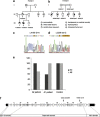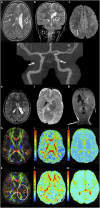COL4A2 mutation associated with familial porencephaly and small-vessel disease
- PMID: 22333902
- PMCID: PMC3400734
- DOI: 10.1038/ejhg.2012.20
COL4A2 mutation associated with familial porencephaly and small-vessel disease
Abstract
Familial porencephaly, leukoencephalopathy and small-vessel disease belong to the spectrum of disorders ascribed to dominant mutations in the gene encoding for type IV collagen alpha-1 (COL4A1). Mice harbouring mutations in either Col4a1 or Col4a2 suffer from porencephaly, hydrocephalus, cerebral and ocular bleeding and developmental defects. We observed porencephaly and white matter lesions in members from two families that lack COL4A1 mutations. We hypothesized that COL4A2 mutations confer genetic predisposition to porencephaly, therefore we sequenced COL4A2 in the family members and characterized clinical, neuroradiological and biochemical phenotypes. Genomic sequencing of COL4A2 identified the heterozygous missense G1389R in exon 44 in one family and the c.3206delC change in exon 34 leading to frame shift and premature stop, in the second family. Fragmentation and duplication of epidermal basement membranes were observed by electron microscopy in a c.3206delC patient skin biopsy, consistent with abnormal collagen IV network. Collagen chain accumulation and endoplasmic reticulum (ER) stress have been proposed as cellular mechanism in COL4A1 mutations. In COL4A2 (3206delC) fibroblasts we detected increased rates of apoptosis and no signs of ER stress. Mutation phenotypes varied, including porencephaly, white matter lesions, cerebellar and optic nerve hypoplasia and unruptured carotid aneurysm. In the second family however, we found evidence for additional factors contributing to the phenotype. We conclude that dominant COL4A2 mutations are a novel major risk factor for familial cerebrovascular disease, including porencephaly and small-vessel disease with reduced penetrance and variable phenotype, which might also be modified by other contributing factors.
Figures




Similar articles
-
Chemical chaperone treatment reduces intracellular accumulation of mutant collagen IV and ameliorates the cellular phenotype of a COL4A2 mutation that causes haemorrhagic stroke.Hum Mol Genet. 2014 Jan 15;23(2):283-92. doi: 10.1093/hmg/ddt418. Epub 2013 Sep 2. Hum Mol Genet. 2014. PMID: 24001601 Free PMC article.
-
De novo and inherited mutations in COL4A2, encoding the type IV collagen α2 chain cause porencephaly.Am J Hum Genet. 2012 Jan 13;90(1):86-90. doi: 10.1016/j.ajhg.2011.11.016. Epub 2011 Dec 29. Am J Hum Genet. 2012. PMID: 22209246 Free PMC article.
-
The expanding phenotype of COL4A1 and COL4A2 mutations: clinical data on 13 newly identified families and a review of the literature.Genet Med. 2015 Nov;17(11):843-53. doi: 10.1038/gim.2014.210. Epub 2015 Feb 26. Genet Med. 2015. PMID: 25719457 Review.
-
A mutation in COL4A2 causes autosomal dominant porencephaly with cataracts.Am J Med Genet A. 2016 Apr;170A(4):1059-63. doi: 10.1002/ajmg.a.37527. Epub 2015 Dec 28. Am J Med Genet A. 2016. PMID: 26708157
-
Childhood presentation of COL4A1 mutations.Dev Med Child Neurol. 2012 Jun;54(6):569-74. doi: 10.1111/j.1469-8749.2011.04198.x. Epub 2012 Jan 16. Dev Med Child Neurol. 2012. PMID: 22574627 Review.
Cited by
-
Biallelic Variants in the COLGALT1 Gene Causes Severe Congenital Porencephaly: A Case Report.Neurol Genet. 2021 Mar 9;7(2):e564. doi: 10.1212/NXG.0000000000000564. eCollection 2021 Apr. Neurol Genet. 2021. PMID: 33709034 Free PMC article.
-
Rare pathogenic structural variants show potential to enhance prostate cancer germline testing for African men.Nat Commun. 2025 Mar 10;16(1):2400. doi: 10.1038/s41467-025-57312-9. Nat Commun. 2025. PMID: 40064858 Free PMC article.
-
Monogenic causes of stroke: now and the future.J Neurol. 2015 Dec;262(12):2601-16. doi: 10.1007/s00415-015-7794-4. Epub 2015 Jun 3. J Neurol. 2015. PMID: 26037017 Review.
-
COL4A2 in the tissue-specific extracellular matrix plays important role on osteogenic differentiation of periodontal ligament stem cells.Theranostics. 2019 May 31;9(15):4265-4286. doi: 10.7150/thno.35914. eCollection 2019. Theranostics. 2019. PMID: 31285761 Free PMC article.
-
COL4A2 mutation causing adult onset recurrent intracerebral hemorrhage and leukoencephalopathy.J Neurol. 2014 Mar;261(3):500-3. doi: 10.1007/s00415-013-7224-4. Epub 2014 Jan 5. J Neurol. 2014. PMID: 24390199
References
-
- Dichgans M. Genetics of ischaemic stroke. Lancet Neurol. 2007;6:149–161. - PubMed
-
- Domingues-Montanari S, Mendioroz M, del Rio-Espinola A, Fernandez-Cadenas I, Montaner J. Genetics of stroke: a review of recent advances. Expert Rev Mol Diagn. 2008;8:495–513. - PubMed
-
- Gould DB, Phalan FC, Breedveld GJ, et al. Mutations in Col4a1 cause perinatal cerebral hemorrhage and porencephaly. Science. 2005;308:1167–1171. - PubMed
-
- Govaert P. Prenatal stroke. Semin Fetal Neonatal Med. 2009;14:250–266. - PubMed
-
- Tonk M, Haan J. A review of genetic causes of ischemic and hemorrhagic stroke. J Neurol Sci. 2007;257:273–279. - PubMed
MeSH terms
Substances
LinkOut - more resources
Full Text Sources
Other Literature Sources
Medical
Molecular Biology Databases

